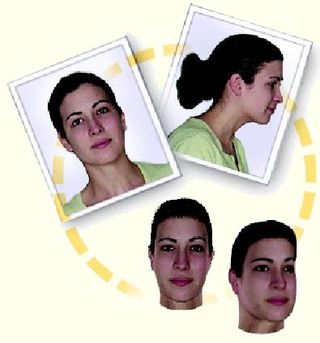Matrox Launches The G550
HeadCasting - 3D From A Comms Angle, Continued

You too can be virtual courtesy of the bundled Digimask application with G550 boards. Matrox does make a case for providing bundled applications with each G550 board that add up to costing more than the retail price of the hardware, if bought as standalone applications. Then again, how many of the bundled applications would fine their way into Matrox' users hands if Matrox hadn't bundled them with the boards?
Sebastian Macdougall, Matrox' spokesman, reiterated the company's positioning of this feature as exclusive to its bundled applications, "The T&L unit is not used for gaming because games and benchmarks do not make heavy use of Matrix Palette Skinning, a feature that our hardware is specifically designed for and very efficient at. Our T&L unit is not optimized for T&L with regular gaming use. Therefore, Matrox will not be dedicating any resources in driver development, optimization, testing and support for hardware T&L as it does not benefit the end user. The focus of this card is to introduce never-before-seen application areas in 3D, at a low price-point such that many people can benefit from this application area and adapt to it."
I am sure Matrox will market HeadCasting, and will be able to demonstrate it effectively. I am also willing to say that it seems inconceivable that Matrox can generate momentum for this technology when it requires the alignment of so many things:
- User demand/interest in VOC - very debatable
- User demand has to translate into communications channels being created that would specify the G550 at both ends - this applies to the Headfone application in the main
- CRM applications address as broad a user base as possible, and are designed to reduce costs - it would seem a stretch to expect companies to put animated heads on the Web to provide live support when most CRM applications try to avoid live services, and push the customer to automated Web activities
I personally did have a soft spot for the PowerPoint presentation. It has a certain cool factor, but you're not going to create much of a graphics card business out of that one feature alone.
It's best to concentrate on the strengths of the G550 then, its failings.
G550 - MS-Office Guy's Last Hurrah?
Most average computer users, or most users, don't even know what graphics chip, or board is in their system. And, despite all the marketing dollars that go into it, 3D acceleration is not the single most pressing graphics issue for the computer industry. So, as far as MS-Office guy is concerned, 3D games and OpenGL applications are not the issue. Therefore, I have no hesitation in saying that Matrox has a product in the G550 that is right up MS-Office guy's street - it will just have a very hard time getting due respect on its merits if considered on the basis of its 3D abilities.
The really good news is that the retail version of the G550 will be available from Matrox's online store for $125 ESP in August. That's a heck of good price for a product that should have the best 2D performance, and deliver high-quality dual screen support. If you are going to deliver dual-screen support then, it has to be good, and Matrox does have the edge over its competitors in that department. Again, at $125, a dual-screen user is going to find this a value product.
Stay on the Cutting Edge
Join the experts who read Tom's Hardware for the inside track on enthusiast PC tech news — and have for over 25 years. We'll send breaking news and in-depth reviews of CPUs, GPUs, AI, maker hardware and more straight to your inbox.

The first G550 boards should be available in retail in August with an ESP of $125.
Mr. Macdougall of Matrox says, "Matrox is the only company that has found a work around which allows Windows 2000 to recognize our single chip device as a multi-display device and therefore offer true multi-display. The use of true multi-display ensures that you can set your resolutions and color depths independently especially if you have different sized monitors and that the OS behaves in a multi-display environment thereby ensuring that all the dialog boxes pop up in the right places and the maximize buttons work properly."
Current page: HeadCasting - 3D From A Comms Angle, Continued
Prev Page HeadCasting - 3D From A Comms Angle Next Page G550 - MS-Office Guy's Last Hurrah? ContinuedMost Popular

